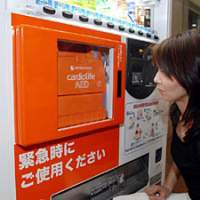Dear Alice,
Did I see what I think I saw? On a recent trip to Japan, I spotted what appeared to be a vending machine containing an AED [Automated External Defibrillator]. I couldn't stop to check it out, but it's been on my mind ever since. What the heck would a life-saving device be doing in a vending machine? I am certified in the U.S. in the use of the AED. Would I be allowed to use one if, on my next visit, someone collapsed near me?
Steve L., Connecticut USA
Dear Steve,
That was a lucky spot of spotting. The first AED-equipped vending machine was put in place just last August, and so far, there are only about 130 in operation, all in Japan. This interesting innovation is just one of the ways in which Japan is leading the world in AED deployment, after years of being far behind. In fact, if you're planning to have a heart attack, Japan may be the best place to have it.
For the benefit of readers who have no idea what we're talking about, an AED is a portable device used on someone suffering from cardiac arrest. To get the heart going again, the AED delivers an electric shock through pads placed on the outside of the chest.
If the heart resumes its proper rhythm, the victim has been defibrillated. This needs to happen quickly because the chance of survival decreases by 10 percent for every minute the victim remains in cardiac arrest without being defibrillated. Which means that by the time an ambulance with an AED arrives, most victims are unlikely to survive. In an effort to shorten the time between collapse and defibrillation, AEDs are increasingly being placed in locations where people congregate, including office buildings, shopping centers, schools, airports and train stations.
Placement is happening faster in Japan than anywhere else in the world, according to Dr. Hideo Mitamura, a cardiologist who led a lengthy battle to get the rules on AEDs changed. Until July 2004, only medical and emergency personnel were allowed to operate an AED in Japan, but now lay people can use them as well.
"It's amazing how fast AEDs have been disseminated since the rules changed," Mitamura told me in an interview at Saiseikai Central Hospital in Tokyo, where he serves as deputy director. "In 2006, 45,000 AEDS were sold and placed around Japan, making this the second largest market after the United States."
Unfortunately, a number of tragedies occurred before Japan brought its laws into line with international recommendations by allowing public access to AEDs.
The most publicized was the death of Prince Takamado, a member of the Imperial family who collapsed in September 2002 while playing squash. Although an ambulance arrived within eight minutes, paramedics were too late to resuscitate the prince. He almost certainly would have survived had an AED been on site, Mitamura asserts.
Another tragic case was 14-year-old Shunpei Inage, who collapsed and died after running at school in June 2004, just one month before AED use by lay people was approved. His parents set up a foundation that has successfully pushed for AEDs in every high school in Hokkaido.
But let me get back to your questions. In workplaces, people tend to use a vending machine on a regular basis, so placing the AED in a vending machine means people are more likely to learn its location and be able to get it quickly in case of an emergency. It also saves space to put the AED into the vending machine rather than having a separate housing for it. Of course you don't need money to get at the AED; it's behind an unlocked door fitted with an alarm to discourage theft and alert bystanders that an emergency is in progress.
Steve, you are qualified to use an AED in Japan. As it turns out, so am I. And so is everyone reading this article. In Japan, lay people don't have to have had training before using an AED in an emergency situation.
"We pushed hard that there be no requirement that laypeople be trained because the machines are very safe and easy to use," Mitamura explained.
The AED diagnoses whether a shock is really needed and gives automated, step-by-step voice instructions. (In Japan, most AEDs speak only Japanese.)
"Japan was very late in allowing public access to AEDs," Mitamura acknowledged, "but we went a big step ahead of Western countries by not requiring training."
That said, it's better to know your way around an AED before you have to use one. If you understand Japanese, training is available at fire stations throughout the country. It's free, although you may have to pay for a textbook.
I looked for courses in English but didn't find any. If you know of organizations that provide training in languages other than Japanese, please let me know and I'll share the information in future columns. If you put a group together and provide your own interpreter, your fire station should be willing to send a trainer.
Let's all get some training. We might just save a life.



















With your current subscription plan you can comment on stories. However, before writing your first comment, please create a display name in the Profile section of your subscriber account page.